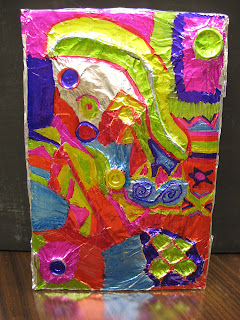Candy Bar Wrapper
Lesson Objective: SWBAT measure and draw a grid in order to enlarge a picture three times it's original size.
Essential Skill to be Mastered: To use math skills to measure and draw a grid. To enlarge and paint a picture 3 times it's original size.
I Can Statement: I can correctly measure a grid and enlarge a picture.
Teaching Strategy: Day 1 - I show students examples of the project and ask them how they think that other students were able to draw something that looked really close to the orignal picture but much larger. We discuss measuring and how we use it in our lives. I then have students pick a black and white copy of a candy bar wrapper of their choosing. I have them follow along with me when making the grid on the original picture. I then model how to create the grid on the larger paper and show them how to transfer the picture. I use guided practice throughout the project and check for grid accuracy. I write the instructions on the front board to ensure the instructions are always there when needed. I have students write a reflection at the end of the project telling about their thoughts on the project and I have them grade their own work giving an explanation for that grade.
Materials:
Candy bar wrapper copies
Pencil
Ruler
Poster paper roll
Tempera paint
Paint brush
Water
Paper towels
Instructions:
1. Draw a grid on the candy bar copy by making an "X" going from top left corner to the bottom right corner and so on.
2. Then measure the width and the height and divide both in half. Use those measures to make a centered "t" in the middle of the picture over the "X" that is already there.
3. Make a line halfway between the edge of the picture and the vertical line of the "t" on both sides.
4. Do the same with the horizontal line.
5. Multiply the width and the height both by 3.
6. Using those numbers draw a larger box on the poster paper (after a piece has been cut off the roll).
7. Insert the same grid on the larger box.
8. Transfer one section at a time to the large paper, meaning, do not try to draw one whole letter at a time, only draw in each section what is in the corresponding section on the small copy.
9. Paint the picture to correspond with the original.

